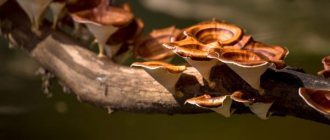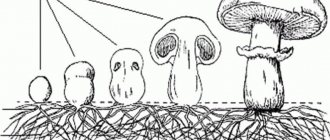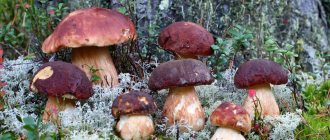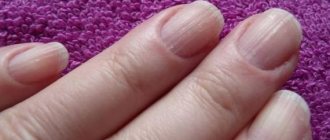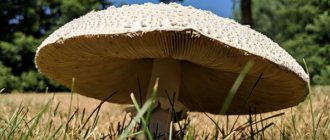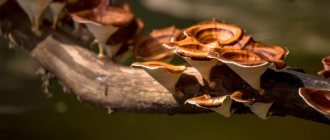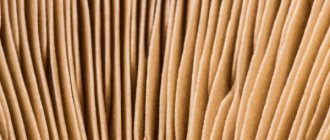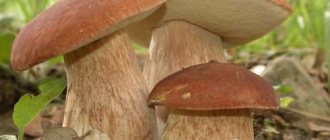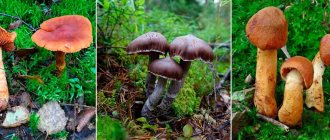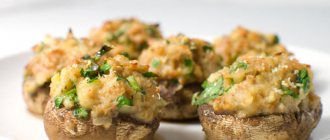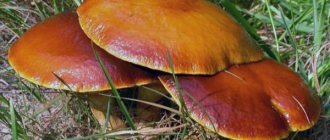What are the cap and stem of a mushroom?
The cap is the main part of the fruiting body
. The lower part of the cap is covered with a hymenophore (spore-bearing layer of the cap). Spores are formed on the hymenophore in the hymenium, with the help of which fungi reproduce.
When identifying individual types of mushrooms, we pay special attention to the shape of the cap, the nature of its surface, color and size.
Cap shape
can be: spherical, hemispherical, oval, cushion-shaped, bell-shaped, tuberculate, flat, funnel-shaped and cone-shaped.
The surface of the cap can be: smooth, pitted, folded, furrowed, bare, velvety, slimy, felted, hairy, fibrous, flaked, scaly, matte, shiny, sticky or dry.
The edge of the cap can be straight, wavy-curved, curled down and up, sharp or rounded with or without remnants of the cover.
Cap color: can be a variety of different tones and shades.
Cap sizes vary
.
If the diameter of the cap of many types of honey mushrooms or collibias is only 15-20 mm, then in some types of mushrooms it reaches 200-350 mm. The cap of the large variegated umbrella mushroom (Macrolepiota procera) reaches 500 mm.
In addition to the above-mentioned signs, when determining, it is necessary to pay attention to the nature of the surface of the cap, its hygrophanicity, the nature of the relationship of the skin with the pulp (it is separated or not separated from the pulp at all).
The hymenophore of the capped fruiting bodies of mushrooms is: veined, lamellar, spinous, tubular, smooth.
The veins can be thick or thin, frequent or sparse, simple or branched, often connected to each other by septa, anastomoses (anastomosis) of different colors.
The spines can be short or long, thick or thin, pointed or blunt; frequent or rare, fragile or elastic, different tones and shades.
The plates can be wide or narrow, dense or sparse, thin or thick, differently attached to the stalk.
The main feature is the nature of the edge of the plates, but you should also pay attention to their shape - what they are: solid, eaten, finely grooved, jagged, sawtooth or covered with flakes. To the touch, the plates can be: hard, soft, elastic or brittle. A very important feature is the color of the plates, which can be white, cream, ocher, pink, blood red, yellow, blue, violet, green, light brown, dark brown or black.
In species of some genera of agaric fungi, the initial color of the plates changes as the fruiting bodies mature, depending on how the ripening and ripe spores are colored.
This phenomenon, for example, is observed in species of the genera Volvariella, Entoloma, champignon Agaricus, Cortinarius, Hypholoma, etc. In young fruiting bodies of some species of spider webs, the plates are blue, green , purple, yellow, cream or reddish color. And in old fruiting bodies, mature spores change the color of the plates to brown or rusty brown.
The tubes can be short or long, easily separated from the pulp or not separated at all, attached to the stem, notched, free, separated or descending.
The tubes are most often white, yellow, reddish, yellow-green, olive, yellow-brown or gray-pink. As the fruiting body matures, the color of the tubes usually changes. The color of the tubes in many species changes upon contact with air.
The mouth of the tubes is usually called pores.
First of all, you should pay attention to their shape, size and color. The color of the pores can change at different stages of development and does not always coincide with the color of the tubes. In some species, when light pressure is applied to the pores, brown or brownish-pink spots remain on them.
The structure of the leg.
The leg can be solid or hollow. Its pulp can be hard, soft, fragile, watery, leathery, elastic, cartilaginous, etc. During the growth period of the fruiting body, the stem lifts and supports the cap. Depending on how the leg is attached to the cap, there are central, eccentric and lateral legs. First of all, we pay attention to the shape, size, surface and color.
The shape of the leg can be barrel-shaped, cushion-shaped, club-shaped, cylindrical and fusiform.
A very important feature is the end of the basal part of the stalk, which can be blunt, rounded, conically narrowed, tuberous or with a root-like outgrowth.
The surface of the leg can be smooth, longitudinally fibrous, wrinkled, ribbed, mesh, bare, velvety, flaky, scaly, mucous, sticky or dry, shiny or matte.
The color of the leg is also important. It can be single-colored or multi-colored, or have a rich range of colors.
The most famous are cap mushrooms, such as porcini mushrooms, boletus and aspen mushrooms, chanterelles, milk mushrooms, saffron milk caps and many others.
The structure of a cap mushroom. Most edible mushrooms (except truffles, strings and morels) have a fruiting body, which is formed by a stalk and a cap.
What we call mushrooms in everyday life are essentially their fruiting bodies. The mycelium itself (the main part of each mushroom) is located in the soil. It consists of thin branching white threads. Each cell of the mycelium in cap mushrooms in most cases contains two nuclei. There are no plastids in fungal cells.
The fruiting bodies of cap mushrooms serve to produce spores, which in turn serve for reproduction.
Tubes and plates make it possible to increase the surface on which spores form many times over. Even a small fruiting body produces millions of spores, and often there are tens or even hundreds of millions of them. The spores of cap mushrooms are very small and light and are carried by air currents. In addition, squirrels and other small animals, storing mushrooms, contribute to the spread of spores.
Once in favorable conditions, that is, warm and humid, the spore germinates into a hypha. Hyphae grow, branch, and the number of cells in them increases.
Gradually, mycelium is formed, consisting of many hyphae. Mycelium, or mycelium, is the vegetative part of the mushroom. This is that white “web”, well known to mushroom pickers, which can often be seen in the forest on fallen branches and leaves, on bare soil. But the main part of the mycelium is hidden under the surface of the soil.
Mycelium is the main state of the fungus. The fungus can remain in this form for a long time, but for reproduction the spores must mature.
Where there are too many mushroom pickers and the fruiting bodies do not have time to produce spores, the mushrooms thin out and even disappear altogether, as, for example, near nearby cities.
Most mushrooms form fruiting bodies in late summer and early autumn.
But there are also very early mushrooms. Already at the end of April, morels are collected in the middle zone. Their quarrels form not on the bottom, but on the top side of their wrinkled hats.
Both the cap and the stem of the fruiting body consist of mycelium threads tightly adjacent to each other.
However, if all the threads in the stem are the same, then in the cap they form two layers - the upper one, covered with skin, often colored with different pigments, and the lower one.
In some mushrooms, for example, in the porcini mushroom, boletus, and oiler, the lower layer is penetrated by numerous tubes. Tubular mushrooms have this structure of the lower part of the fruiting body. In lamellar mushrooms, the lower layer of the fruiting bodies has numerous plates (saffron milk caps, russula, volnushki).
Education dispute
Spores (special cells with the help of which mushrooms reproduce) are formed in tubes or on the plates of the cap. The spores are very small and light. After ripening, they spill out, are easily picked up and carried by the wind.
In addition, they can be spread by insects and slugs, as well as squirrels and hares that eat mushrooms. In the digestive organs of these animals, the spores are not digested and are thrown out along with the droppings.
Once in moist, humus-rich soil, fungal spores germinate and mycelium threads develop from them.
Only occasionally can a mycelium grown from one spore form new fruiting bodies. In most species of fungi, fruiting bodies develop on myceliums formed by fused cells of filaments grown from different spores. A feature of this fusion of two cells is the process of interaction of their nuclei. They do not merge, but only connect in pairs. Therefore, the cells of such a mycelium remain binuclear for a long time and only then merge.
The mycelium grows slowly, and only after accumulating sufficient reserves of nutrients does it form fruiting bodies.
Symbiosis of fungi and plants
Cap mushrooms absorb water, mineral salts from the soil, as well as organic substances formed in the soil as a result of the decomposition of plant residues.
Many cap mushrooms obtain organic matter from tree roots.
Mushroom pickers are well aware that boletus grows under birch trees, aspen boletus grows in aspen forests, and boletus grows under pine and larch trees. This connection between mushrooms and trees is explained by the fact that the mycelium of certain types of mushrooms comes into close contact with the roots of certain tree species.
In this case, the mycelial hyphae entwine the root and even penetrate into its cells. The relationship between a mushroom and a tree is “beneficial” for both parties. The roots of the tree receive water and mineral salts from the fungus, and the mushroom from the roots of the tree receive organic substances necessary for nutrition and the formation of fruiting bodies. Such connections between different organisms are called symbiosis.
The symbiosis of fungal mycelium with roots is called mycorrhiza.
Many cap mushrooms form mycorrhizae, but not all. This is how one of the most valuable edible mushrooms, champignon, does not form mycorrhiza.
Recognizing edible and poisonous mushrooms
Mushrooms with a fruiting body are divided into:
- poisonous
- false honey,
- ordinary line,
- death cap;
- inedible
- fly agaric,
- common veselka;
- conditionally edible
- pink wave,
- morel cap;
- edible
- White mushroom,
- autumn honey fungus.
To recognize edible and inedible mushrooms, you need to be guided by appearance or have experience as a mushroom picker. If you are not sure that the mushroom you see is edible, then it is better not to take it. When collecting, pay attention to external signs and carefully examine the fruiting bodies.
The importance of mushrooms in nature and in human life
| In nature | In human life |
| Included in the process of substance circulation. | One of the power sources. |
| Participate in the formation of the soil layer. | Used in the baking industry. |
| They form a symbiosis with plants (mycorrhiza). | Used to create wine and alcohol-containing products. |
| They are a source of food for birds, mollusks, insects, and animals. |
|
Rice. 4. Mold growth and spore formation
Note: Many mushrooms cause serious damage to humans. They parasitize plants and animals, cause spoilage and rotting of food products, and destroy leather, wood, and paper products. Ancient manuscripts and works of art suffer from them.
Recommendations for collecting mushrooms
Among the cap mushrooms there are both edible and poisonous. Of the edibles, the most valuable are champignons, white mushrooms, boletus mushrooms, boletus mushrooms, boletus mushrooms, and milk mushrooms. Fruiting bodies of different species of mushrooms are formed at different times.
At the end of April - beginning of May, morels and lines appear. A little later - champignons. In mid-June, when the rye is heading, boletus mushrooms appear.
Following them are boletus, boletus, and russula. From the second half of summer until frost, mushrooms of all types form fruiting bodies.
When collecting, it is advisable to handle the mycelium as carefully as possible. There is no need to dig mushrooms out of the soil, as this will damage the mycelium. You should use light, careful movements to twist the fruit tepas out of the soil.
In this case, the mycelium threads are almost not damaged.
If the weather is dry, the fruiting bodies of the mushrooms begin to grow only at the end of summer. As soon as the air temperature drops steadily, their growth stops.
When picking mushrooms, you must use the main rule - if you are not completely sure that the mushroom is edible, it is better not to take it. The fly agaric and toadstool have a high content of toxic substances. Double mushrooms are especially dangerous: false chanterelles and false honey mushrooms and others, since they are very similar to edible ones.
Pale toadstool mushrooms are very similar in appearance. However, the underside of the toadstool's cap is greenish-white, while the champignon's is pink.
The fly agaric has a distinctive bright red cap with white spots, although fly agarics are sometimes found with gray caps.
The porcini mushroom has its own counterpart - the gall mushroom.
However, the upper part of the gall mushroom stump is covered with a pattern in the form of a black or dark gray mesh, and its flesh, unlike the pulp of the porcini mushroom, turns red at the break. False chanterelles are also similar to edible chanterelles, but their caps are smooth, reddish-orange, rather than light yellow like the edible ones. In addition, white juice is released from the broken cap of the false chanterelle.
Edible honey mushrooms have a ring of film on the stump.
False honey mushrooms do not have such a film and their plates under the cap are greenish.
In some years, in some areas, edible mushrooms may contain toxic substances. In addition, old fruiting bodies of edible mushrooms can also become poisonous. It is dangerous to eat mushrooms grown near highways, chemical and other industrial enterprises that pollute the environment with harmful substances. Mushrooms grown in areas contaminated with radionuclides pose a great danger.
The fruiting bodies of fungi are capable of intensively accumulating these substances.
Materials: https://biofile.ru/bio/1103.html
Types of fruiting bodies
Representatives of the mushroom kingdom have different shapes.
In many sources there is a division into groups:
- hat-footed;
- sessile - in the form of growths, hooves, cantilever-shaped (they lack a leg or stump, hence the name);
- round, pear-shaped, etc.;
- prostrate, lobed, in the form of corals, ear, star, etc.
The shape of the mushroom's fruiting body may change during growth. There are species that look like a star and acquire a phallus- or lobe-like appearance.
Cap mushrooms
In everyday life, mushrooms are the fruiting bodies of cap mushrooms.
The fruiting body consists of a cap and a stalk (the stalk is also called a stump). The hat can be painted in different colors (brown, bluish, red, etc.). There are cap mushrooms that do not have legs (truffles, morels).
In addition to the fruiting body, cap mushrooms have mycelium (mycelia), characteristic of all species belonging to the kingdom Mushrooms.
You can see the mycelium of the cap mushroom in the soil near the surface. Usually it is a plexus of thin branching threads of a whitish color. It is the mycelium that is the main body of the fungus, while the fruiting bodies serve for reproduction.
Mycelium hyphae
The thread (hyphae) of the mycelium consists of one row of long cells.
Each cell can have several nuclei. Fruiting bodies grow on the mycelium; they consist of the same hyphae, but tightly adjacent to each other. In the mushroom cap, the hyphae form two layers. The top layer is covered with skin, the color of which is given by various pigments.
The bottom layer of the cap may contain either tubes or plates. In the first case, these are tubular mushrooms (boletus, boletus), in the second - lamellar (russula, saffron milk caps).
Tubular mushroom (oil can)
Lamellar mushroom (russula)
Cap mushrooms, like all fungi, do not have chloroplasts (like other plastids), and therefore are not plants and cannot eat through photosynthesis.
Cap mushrooms feed by absorbing organic substances from the soil along with water and inorganic substances by the mycelium.
Therefore, mushrooms grow in places where there is a lot of humus, the partial decomposition of which enriches the soil with organic matter.
Another way of feeding mushrooms is through symbiosis with trees. Many cap mushrooms penetrate the roots of trees with their hyphae. The so-called mycorrhiza is formed.
Through it, the fungus receives organic substances from plants. The tree receives water and minerals from the fungus, which are absorbed by the branched mycelium from a large area of soil.
Each type of mushroom is able to enter into symbiosis only with certain trees. So saffron milk caps form mycorrhizae with pines and spruces, boletus mushrooms with birch trees, etc. Accordingly, these mushrooms can only be found near “their” trees.
Mushroom reproduction is carried out by spores that are formed in the tubes or plates of the lower layer of the cap. Fungal spores are small and light enough to be spread by wind. In addition, they are often spread by invertebrates on their bodies, or by vertebrates that eat the fungi.
In the digestive tract of animals, the spores are not digested and are excreted along with the droppings. Once in favorable conditions, the fungal spore germinates, gradually forming a large mycelium. After some time, fruiting bodies begin to grow on the mycelium.
The fruiting bodies of many mushrooms are edible (boletus, porcini mushroom, boletus, champignons, russula, etc.). However, there are also many poisonous mushrooms (white toadstool, fly agaric, false mushrooms, etc.).
In addition, old fruiting bodies also become poisonous. Mushrooms accumulate heavy metals, so they should not be collected near roads or in industrial areas.
Materials: https://biology.su/fungus/blewits
Mysteries of a special kingdom
Mushrooms are special and wonderful creatures. So much so that biologists have separated them into a separate kingdom - the Kingdom of Mushrooms - diverse, mysterious and, to this day, full of secrets and mysteries. Currently, scientists know about 100 thousand species of mushrooms, but this is only part of their huge world. The constant study of the vast expanses of the Kingdom of Mushrooms by mycologists continues to this day, and will bring many more discoveries.
We are all accustomed to collecting and eating edible mushrooms, without really thinking about how they are structured, but for an inquisitive seeker, information about their structure will not be superfluous at all.
Mysteries of the mushroom kingdom
What do mushrooms and animals have in common?
Fungi are special organisms that occupy a unique place between the plant and animal kingdoms. They are heterotrophs, like animals, that is, they cannot independently synthesize organic substances from inorganic compounds, like plants, but must receive nutrients from the external environment. In addition, they have the following properties in common with animals:
- Presence of chitin in the cell wall.
- Lack of plastids.
- The presence of lysosomes containing digestive enzymes.
- Presence of small storage vacuoles.
- Glycogen is used as a reserve nutrient rather than starch.
What do mushrooms and plants have in common?
In terms of their lifestyle, mushrooms are still more similar to plants. For a long time they were classified as part of the plant kingdom. They are similar to plants:
- Growing in one place
- Nutrition through the process of absorption, that is, the absorption of nutrients.
- Opportunities for unlimited growth.
- Reproduction by spores.
- Presence of a cell wall.
- Absence of a cell center.
- Presence of vacuoles in the cell.
What are mushrooms made of?
Mono- or multinucleated fungal cells are usually covered with a thin cell membrane. Underneath it is a cytoplasmic membrane that envelops the cytoplasm.
The fungal cell contains proteins, enzymes, and lysosomes, in which proteins are broken down by proteolytic enzymes. Mitochondria have general similarities with those of higher plants. Vacuoles contain reserve nutrients: fats, glycogen, lipids, fatty acids.
Edible mushrooms contain many vitamins and mineral salts. Approximately 50% of their dry mass is nitrogenous substances, of which proteins account for about 30%.
In our world, mushrooms are everywhere - from microscopic mold to giants a meter tall. They live wherever living organisms can live, and their role in the cycle of life is enormous. Fungi are decomposers—organisms that feed on dead organic remains and mineralize these remains into simple organic compounds.
Many types of fungi live in symbiosis with higher plants, forming mycorrhizae with their root system. Like boletus with birch.
Some higher plants cannot grow normally without mycorrhiza. Fungi receive oxygen, root secretions and nitrogen-free compounds from higher plants, and in return help them absorb hard-to-reach substances from humus, activating the activity of higher plant enzymes. They also contribute to their carbohydrate metabolism, fix free nitrogen, and provide growth substances and vitamins to higher plants.
Subkingdoms of mushrooms
The mushroom kingdom is divided into two subkingdoms:
- The lower ones are composed of one cell.
- Higher ones have multicellular mycelium.
